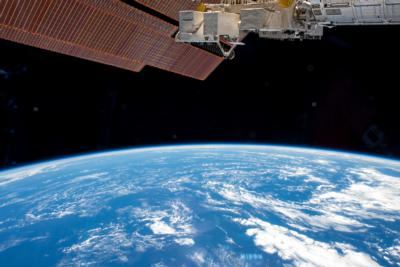Sat, Nov 28, 2020
Prepping Now for Dragon Cargo Mission
The seven-member Expedition 64 crew from the United States, Russia and Japan took the day off on Thanksgiving before ending the week with a day full of microgravity research. The crew spent Wednesday on a wide array of space science while getting the International Space Station ready for an upgraded SpaceX Dragon resupply ship.

NASA Flight Engineers Kate Rubins and Shannon Walker worked throughout Wednesday readying the station’s Tranquility module for a new commercial airlock from NanoRacks. Dubbed Bishop, the airlock will be delivered on the next SpaceX Dragon cargo mission targeted to launch on Dec. 5. The Bishop airlock will enable private industries to increase research opportunities in the vacuum of space.
Planned for Dec. 6, this will be the first automated docking of the Cargo Dragon to the space-facing port on the Harmony module. Previous Cargo Dragon vehicles were captured with the Canadarm2 robotic arm maneuvered by astronauts. Robotics controllers then took over and remotely installed Dragon to Harmony’s Earth-facing port.
The GRASP human research experiment, sponsored by the European Space Agency (ESA), was back on the science schedule Wednesday. Flight Engineers Michael Hopkins and Victor Glover wore virtual reality goggles and responded to virtual stimuli to help doctors understand how the central nervous system, specifically hand-eye coordination, adapts to weightlessness.
JAXA astronaut and Flight Engineer Soichi Noguchi started his day servicing the Kibo laboratory module’s Cell Biology Experiment Facility, a specialized incubator that can generate artificial gravity. Later, he joined Kate Rubins and examined her eyes using optical coherence tomography.
The orbiting lab’s two cosmonauts, Commander Sergey Ryzhikov and Flight Engineer Sergey Kud-Sverchkov, continued studying ways to make space workouts more effective. The duo later joined Rubins and practiced chest compressions, or cardiopulmonary resuscitation, in the event of a medical emergency aboard the space station.
More News
He Attempted To Restart The Engine Three Times. On The Third Restart Attempt, He Noticed That Flames Were Coming Out From The Right Wing Near The Fuel Cap Analysis: The pilot repor>[...]
Make Sure You NEVER Miss A New Story From Aero-News Network Do you ever feel like you never see posts from a certain person or page on Facebook or Instagram? Here’s how you c>[...]
From 2009 (YouTube Edition): Leading Air Show Performers Give Their Best Advice for Newcomers On December 6th through December 9th, the Paris Las Vegas Hotel hosted over 1,500 air >[...]
Aero Linx: NASA ASRS ASRS captures confidential reports, analyzes the resulting aviation safety data, and disseminates vital information to the aviation community. The ASRS is an i>[...]
“For our inaugural Pylon Racing Seminar in Roswell, we were thrilled to certify 60 pilots across our six closed-course pylon race classes. Not only did this year’s PRS >[...]
 NTSB Final Report: Rutan Long-EZ
NTSB Final Report: Rutan Long-EZ ANN FAQ: Turn On Post Notifications
ANN FAQ: Turn On Post Notifications Classic Aero-TV: ICAS Perspectives - Advice for New Air Show Performers
Classic Aero-TV: ICAS Perspectives - Advice for New Air Show Performers ANN's Daily Aero-Linx (06.28.25)
ANN's Daily Aero-Linx (06.28.25) Aero-News: Quote of the Day (06.28.25)
Aero-News: Quote of the Day (06.28.25)



